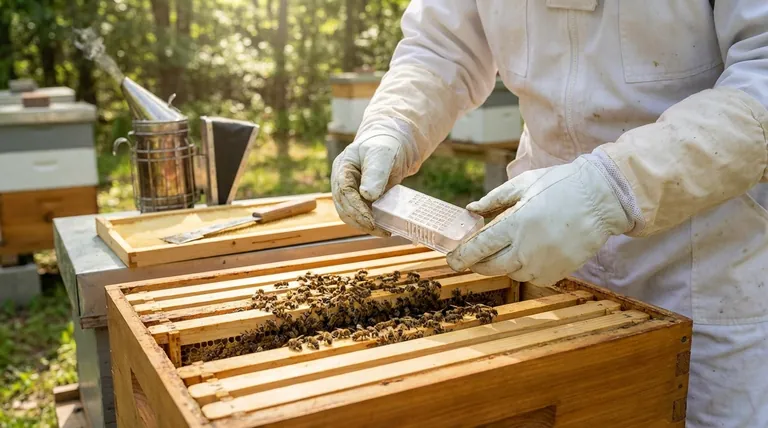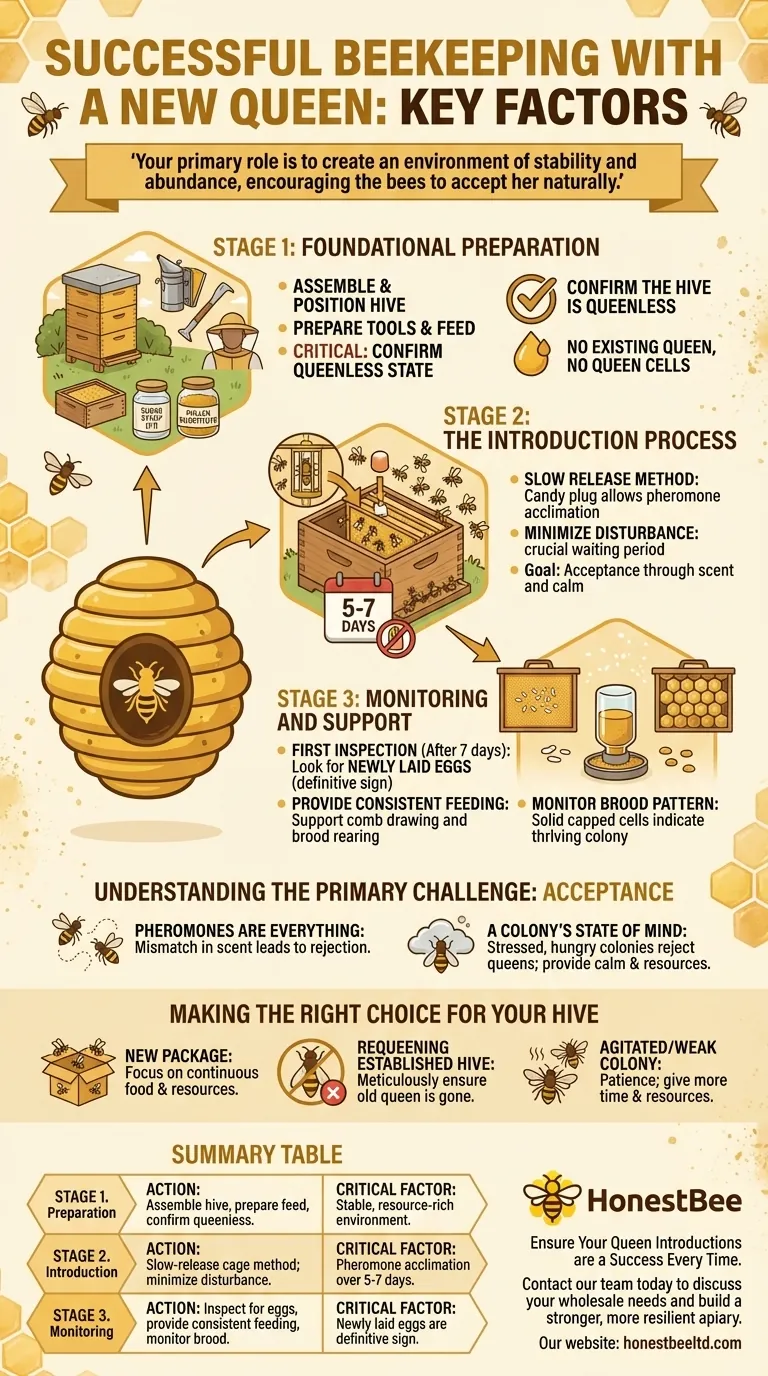The key factors for successful beekeeping with a new queen are diligent preparation, a calm and correct installation process, and consistent post-introduction support. Success depends on creating the ideal conditions for the colony to accept the new queen as their own, which involves providing resources and minimizing stress on the hive.
Your primary role is not to force a new queen on a colony, but to create an environment of stability and abundance that encourages the bees to accept her naturally. The goal is to convince the hive that she is their best option for survival and prosperity.

Stage 1: Foundational Preparation
Before your new queen arrives, your focus should be on preparing her future home and ensuring all your equipment is ready. A smooth introduction begins with a well-planned setup.
Assemble and Position the Hive
Ensure all hive components are fully assembled, painted, and positioned in their final location in your bee yard. This prevents last-minute scrambling and unnecessary disturbance to the bees.
Prepare Your Tools and Feed
Have your protective gear, hive tool, and a smoker or sugar spray ready. Crucially, prepare sugar syrup (a 1:1 ratio of sugar to water) and a pollen substitute. These resources are vital for a new or stressed colony.
Confirm the Hive is Queenless
This is the most critical step before introducing a new queen to an existing colony. A hive will not accept a new queen if they already have one or believe they can make their own. You must confirm there is no existing queen and no queen cells.
Stage 2: The Introduction Process
The day you introduce the queen is a delicate operation. Your calmness and adherence to a proven method are paramount to success.
The Slow Release Method
The new queen typically arrives in a small cage with a candy plug. Place this cage between two frames in the center of the brood box. The bees will slowly eat through the candy plug over several days.
Why It Works
This slow release gives the colony time to acclimate to the new queen's pheromones (her unique chemical scent). By the time she is released, the bees will have accepted her as the new mother of the colony.
Minimize Disturbance
Once the queen cage is installed, close up the hive and leave it alone for 5-7 days. Resisting the urge to peek is crucial. Opening the hive too soon can cause stress and may lead the bees to reject and kill the new queen.
Stage 3: Monitoring and Support
After the initial waiting period, your role shifts to that of an observer and provider. You must verify acceptance and ensure the colony has the resources it needs to build up.
The First Inspection
After a week, perform a quick, calm inspection. Your goal is to find the queen cage, confirm she has been released, and—most importantly—look for newly laid eggs. Seeing tiny, rice-like eggs centered in the bottom of cells is the definitive sign of success.
Provide Consistent Feeding
A new colony is focused on drawing out comb and raising brood. Continue to provide sugar syrup and a pollen substitute. This support removes the pressure of foraging and allows them to dedicate all their energy to establishing a strong population.
Monitor the Brood Pattern
In the weeks following a successful introduction, you should see a healthy brood pattern. This looks like a solid, condensed area of capped cells, indicating the queen is laying consistently and the colony is thriving.
Understanding the Primary Challenge: Acceptance
A honeybee colony is a complex superorganism with a singular focus on survival. Queen acceptance is not guaranteed; it is a judgment made by the hive.
Pheromones are Everything
The primary reason for rejection is a mismatch in scent. If the new queen's pheromones are too different, or if the hive still senses a previous queen, they will view her as an intruder.
A Colony's State of Mind
A stressed, hungry, or agitated colony is far more likely to reject a queen. This is why providing food and minimizing disturbances are not just helpful tips—they are essential components of the process. Your goal is to create a calm, stable, and resource-rich environment.
Making the Right Choice for Your Hive
Your specific actions should be tailored to the colony's situation.
- If you are installing a brand new package of bees: Your primary focus is providing continuous food and resources to help them build their home from scratch.
- If you are requeening an established hive: Your primary focus is meticulously ensuring the old queen is gone before introducing the new one.
- If the colony seems agitated or weak: Your primary focus is patience; give them more time and resources before expecting a major population boom.
Ultimately, successful queen introduction is a partnership between your knowledge and the bees' natural instincts.
Summary Table:
| Stage | Key Action | Critical Factor |
|---|---|---|
| 1. Preparation | Assemble hive, prepare feed, confirm queenless state. | A stable, resource-rich environment is foundational. |
| 2. Introduction | Use the slow-release cage method; minimize disturbance. | Pheromone acclimation over 5-7 days is critical for acceptance. |
| 3. Monitoring | Inspect for eggs, provide consistent feeding, monitor brood pattern. | Newly laid eggs are the definitive sign of a successful introduction. |
Ensure Your Queen Introductions are a Success Every Time
A failed queen introduction can set your colony back for an entire season. At HONESTBEE, we supply commercial apiaries and beekeeping equipment distributors with the reliable, high-quality supplies needed for seamless hive management. From durable queen cages and feeders to essential hive tools, our wholesale-focused operations ensure you have the right equipment to support your colonies.
Let our expertise in beekeeping supplies help you minimize losses and maximize productivity. Contact our team today to discuss your wholesale needs and build a stronger, more resilient apiary.
Visual Guide

Related Products
- Professional Multi-Functional Queen Bee Cage
- Multi-Function Queen Roller Cage and Catcher
- Wood and Mesh Push-In Queen Cage
- Durable Galvanized Steel Spring Queen Bee Cage
- Professional Round Push-In Queen Cage with Metal Tines
People Also Ask
- What items are needed to place the queen bee's cage in the hive? A Guide to Successful Queen Introduction
- What are the components of a standard queen cage? A Guide to Safe Queen Introduction
- What should be done if bees damage the queen cage or harm the queen? Rescue Your Queen and Save Your Hive
- What are common mistakes to avoid when using queen cages? Ensure Successful Queen Introduction
- How do you check if the queen has been released after installation? A Guide to Successful Queen Acceptance



















